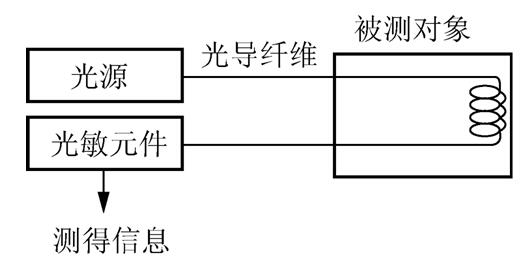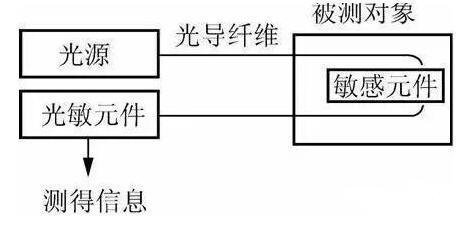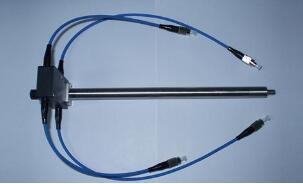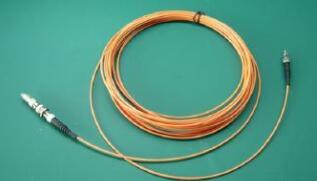
Privacy statement: Your privacy is very important to Us. Our company promises not to disclose your personal information to any external company with out your explicit permission.
The fiber is first used in the transmission of light and is suitable for transmitting information over long distances. It is the cornerstone of optical communication in modern information society. The characteristic parameters of light waves propagating in the fiber will change indirectly or directly due to external factors, so that the fiber sensor can analyze and detect changes in these physical quantities, chemical quantities and biomass.
The fiber optic sensor consists of a light source, an incident fiber, an exit fiber, a light modulator, a photodetector, and a demodulator. The basic principle is that the light of the light source is sent to the modulation zone through the incident fiber, and the light interacts with the measured parameters of the outside in the modulation zone to make certain optical properties of the incident light (such as intensity, wavelength, frequency, phase, and off-normality). The signal light that has been modulated and changed into a modulated signal is sent to the photodetector and demodulator through the exiting fiber to obtain the measured parameter.

Fiber optic sensors can be divided into two categories according to the type of structure: one is a functional (sensing type) sensor; the other is a non-functional (light transmitting type) sensor.
(1) Functional fiber optic sensorAn optical fiber (or a special optical fiber) having sensitivity and detection capability to external information is used as a sensing element to modulate light transmitted in the optical fiber to change characteristics such as intensity, phase, frequency, or polarization state of the transmitted light. The signal to be measured is obtained by demodulating the modulated signal.

The optical fiber is not only a light guiding medium but also a sensitive component, and a multimode optical fiber is often used.
Advantages: compact structure and high sensitivity.
Disadvantages: Special fiber is required and the cost is high.
Typical applications: fiber optic gyroscopes, fiber optic hydrophones, etc.
(2) Non-functional sensorIt is the use of other sensitive components to sense the measured changes. Optical fibers are only used as the transmission medium for information, and single-mode optical fibers are often used. The optical fiber only serves as a light guide, and the illumination is measured and modulated on the fiber-type sensitive component.

Advantages: no special fiber and other special technologies, easy to implement, low cost.
Disadvantages: low sensitivity.
Most of the practical are non-functional fiber optic sensorsDepending on the nature of the modulated light wave, both types of fiber sensors can be subdivided into intensity modulated fiber sensors, phase modulated fiber sensors, frequency modulated fiber sensors, polarization modulated fiber sensors, and wavelength modulated fiber sensors.
1) Intensity modulated fiber optic sensor
The basic principle is that the physical quantity to be measured causes a change in the intensity of the transmitted light in the optical fiber, and the measurement to be measured is realized by detecting the change in the light intensity. The light of intensity I is injected into the sensor head by the constant light source. In the sensor head, the intensity of the light changes under the action of the signal under test, that is, the external field is modulated, so that the envelope of the output light intensity is The shape of the signal to be measured is the same, and the output current measured by the photodetector is also modulated. The signal processing circuit detects the modulated signal and obtains the measured signal.
The advantages of this kind of sensor are simple structure, low cost and easy implementation. Therefore, it has been developed and applied earlier, and has been successfully applied in displacement, pressure, surface roughness, acceleration, clearance, force, liquid level, vibration, radiation, etc. measuring. There are many ways of intensity modulation, which can be roughly divided into reflective intensity modulation, transmission intensity modulation, optical mode intensity modulation, and refractive index and absorption coefficient intensity modulation. Generally, the reflection intensity modulation, the transmission intensity modulation, and the refractive index intensity modulation are called external modulation, and the optical mode is called internal modulation. However, due to the limitation of the principle, it is susceptible to fluctuations in the light source and changes in connector loss, so this sensor can only be used in applications where the interference source is small.
2) Phase modulation fiber optic sensor
The basic principle is: under the action of the measured energy field, the phase of the light wave in the optical fiber changes, and then the interferometric measurement technique is used to convert the phase change into a change in the light intensity, thereby detecting the physical quantity to be tested. The phase modulation type optical fiber sensor has the advantages of high sensitivity, large dynamic measurement range, and fast response speed. The disadvantage is that the requirements for the light source are relatively high and the precision of the detection system is relatively high, so the cost is relatively high. .
At present, the main application areas are: acoustic, pressure or vibration sensors using photoelastic effects; current and magnetic field sensors using magnetostrictive effects; electric field and voltage sensors using electrostriction; and rotational angular velocity sensors using Segnack effect (Fiber Optic Gyro) and so on.
3) Frequency modulation fiber optic sensor
The basic principle is to use the Doppler shift effect of the reflected or scattered light of a moving object to detect its moving speed, that is, the optical frequency is related to the motion state between the light receiver and the light source. When they are relatively stationary, the oscillating frequency of the light is received; when there is relative motion between them, the frequency of the received light is frequency-shifted with its oscillating frequency, and the magnitude of the frequency shift is related to the magnitude and direction of the relative motion speed.
Therefore, such sensors are often used to measure the speed of movement of objects. There are other methods for frequency modulation, such as the absorption and fluorescence of some materials with frequency changes with external parameters, and the Brillouin and Raman scattering of quantum interactions is also a frequency modulation phenomenon. Its main application is to measure fluid flow, and other gas sensors that measure the concentration of gas or monitor atmospheric pollution by Raman scattering when the material is exposed to strong light; temperature sensors that use photoluminescence.
4) Polarization modulated optical fiber sensor
The basic principle is to use the change of the polarization state of light to transmit the information of the object under test.
A light wave is a transverse wave whose light vector is perpendicular to the direction of propagation. If the direction of the light vector of the light wave is always the same, but its size changes with the phase, such light is called linearly polarized light. The plane composed of the light vector and the direction of propagation of the light is the vibration plane of the linearly polarized light. If the size of the light vector remains the same and its direction rotates evenly around the direction of propagation, the trajectory at the end of the light vector is a circle, and such light is called circularly polarized light. If the magnitude and direction of the light vector are regularly changing and the end of the light vector is rotated along an ellipse, such light is referred to as elliptically polarized light.
Polarization-modulated fiber optic sensors can be fabricated using the polarization properties of the light waves. Polarization plays an important role in many fiber optic systems, especially those that include single mode fiber. Many physical effects affect or change the polarization state of light, and some effects can cause birefringence. The so-called birefringence phenomenon is a phenomenon in which a pair of incident light is often decomposed into two refracted lights for a crystal whose optical properties vary with direction. The phase retardation of light through the birefringent medium is a function of the polarization state of the input light.
The polarization state modulation fiber sensor has high detection sensitivity, can avoid the influence of the change of the light source intensity, and the relative phase modulation fiber sensor has a simple structure and convenient adjustment. Its main application areas are: current and magnetic field sensors using Faraday effect; electric field and voltage sensors using bubble effect; pressure, vibration or acoustic sensors using photoelastic effect; temperature, pressure and vibration sensors using birefringence. At present, the most important thing is to monitor high current.
5) Wavelength modulation type optical fiber sensor
The conventional wavelength modulation type optical fiber sensor is realized by utilizing the property that the spectral characteristics of the sensing probe vary with external physical quantities.
Most of these sensors are non-functional sensors. In a wavelength-modulated fiber optic probe, the fiber is simply used as a light guide, that is, the incident light is sent to the measurement area, and the returned modulated light is sent to the analyzer. The key to fiber-optic wavelength detection technology is the good performance of the light source and spectrum analyzer, which has a decisive influence on the stability and resolution of the sensing system.
Optical fiber wavelength modulation technology is mainly used in medicine, chemistry and other fields. For example, analysis of human blood gas, PH value detection, chemical analysis of indicator solution concentration, phosphorescence and fluorescence phenomenon analysis, black body radiation analysis, and Fabry-Perot filter. The so-called wavelength modulation type fiber sensor is mainly referred to as a fiber Bragg grating sensor (FBG).

Fiber optic sensors have the advantages of high sensitivity and accuracy, inherent safety, anti-electromagnetic interference, high dielectric strength, corrosion resistance, integrated sensing and transmission, and compatibility with digital communication systems. Summarized as follows:
(1) High sensitivity;
(2) Light and flexible, easy to install and bury;
(3) Electrical insulation and chemical stability. The fiber itself is a kind of material with high insulation and chemical stability. It is suitable for use in harsh environments such as high voltage isolation and flammability and explosion in power systems and chemical systems.
(4) Good security. The fiber optic sensor is an electrically passive sensitive component, so when it is used in measurement, there are no hidden dangers such as electric leakage and electric shock;
(5) Anti-electromagnetic interference. In general, the frequency of the light wave is higher than the frequency of the electromagnetic radiation, so the propagation of light in the fiber is not affected by the electromagnetic noise;
(6) Distributed measurement. An optical fiber can realize long-distance continuous measurement and control, and can accurately measure the strain, damage, vibration and temperature at any point, and thus form a monitoring area with a wide range to improve the detection level of the environment;
(7) Long service life. The main material of the optical fiber is quartz glass, which is covered with a cladding of a polymer material, which makes it have greater durability with respect to the metal sensor;
(8) The transmission capacity is large. Using optical fiber as the busbar, the large-capacity optical fiber is used instead of the bulky multi-core underwater cable to collect and store the information of each sensing point, and the distributed optical fiber sensor is realized by the multiplexing technology.
Distributed fiber optic sensorDistributed fiber optic sensing technology was developed in the late 1970s and was developed with the advent of the widespread use of optical time domain reflectometry (OTDR) technology in fiber optic engineering. In the past ten years, a series of distributed optical fiber sensing mechanisms and measurement systems have been produced and gradually applied in many fields. Currently, this technology has become one of the most promising technologies in fiber optic sensing technology.
Distributed fiber optic sensors are sensors that measure or monitor spatial distribution and time-varying information along the fiber's transmission path using a unique distributed fiber-detection technique. Using the characteristics of light waves transmitted in the fiber, continuous sensing along the length of the fiber can be measured (such as temperature, pressure, stress and strain). The fiber is both a sensing medium and a measured transmission medium. It arranges the sensing fiber along the field, and can obtain the spatial distribution of the measured field and the change information with time.
Distributed fiber optic sensors have the following features:
1) The sensing elements in the distributed optical fiber sensing system are only optical fibers;
2) The one-dimensional distribution map measured in the entire fiber region can be obtained in one measurement, and the two-dimensional and three-dimensional distribution of the measurement can be measured by arranging the optical fiber in a grating shape;
3) The spatial resolution of the system is generally on the order of meters, so that only the average measured over a narrower range can only be observed as an average;
4) The measurement accuracy and spatial resolution of the system generally have mutual constraints;
5) The detection signal is generally weak, thus requiring the signal processing system to have a higher signal to noise ratio;
6) Since a large number of signal addition averaging, frequency scanning, phase tracking, etc. are required during the detection process, it takes a long time to implement a complete measurement.
Because fiber optic cables are not susceptible to electromagnetic interference, distributed fiber optic temperature sensing systems are commonly used for temperature monitoring and measurement of hotspot locations in power cables. The grasp and management of harsh environments and the improvement of field work environment requirements are the main reasons for the steady growth of the distributed optical fiber temperature sensing system market. At the same time, the technical challenges of sensor cable deployment are also the main obstacles to the development of this market. With the increasing use of applications, distributed fiber optic sensors are now used in six major areas, including structural inspection of pipelines and offshore oil platforms; leakage detection of liquid pipelines and dams; road surface icing detection, railway monitoring; System detection, power cable monitoring; fiber optic communication production monitoring; environmental monitoring and long-term temperature measurement.

December 29, 2023
December 28, 2023
October 14, 2022
อีเมล์ให้ผู้ขายนี้
December 29, 2023
December 28, 2023
October 14, 2022

Privacy statement: Your privacy is very important to Us. Our company promises not to disclose your personal information to any external company with out your explicit permission.

Fill in more information so that we can get in touch with you faster
Privacy statement: Your privacy is very important to Us. Our company promises not to disclose your personal information to any external company with out your explicit permission.